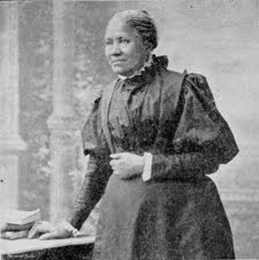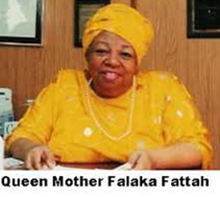On Creating the Portrait of
Frances Ellen Watkins Harper
By Leroy Forney, Artist
The objective of the portrait painter is not only to provide a likeness but to capture the personality and vitality of the subject. A portrait is akin to meeting a person through conversation rather than by merely looking at a photograph of the person.
In approaching the portrait of a living subject I first make several sketches. This allows me to speak with and observe the subject over time, a process that continues throughout the development of the portrait. Thus I come to know the subject through many mood changes – curiosity, interest, boredom, impatience, humor, and more. Building on this background, the portrait becomes a composite that reflects all these intimacies within an authentic context, woven into the likeness of the subject.
Similarly, with a historic figure such as Frances Ellen Watkins Harper, the first step in creating her portrait a century after her death is to clearly recognize her uniqueness. To accomplish this in her absence, I immersed myself in her writings, what has been written about her, the context of her life and times, and her calling.
How to begin? Research at the Library Company of Philadelphia confirms that there are two photographs of Harper at maturity as well as one photograph and one etching of her as a young woman. They have been reproduced in subsequent histories and essays…but all of them portray a woman of great poise, dignity and determination.
 From these choices, the formal photograph taken for the frontispiece of her most famous book is the genesis for the portrait. Specialists at the Philadelphia Museum of Art and at Philadelphia University indicated that the photo dates to about 1895, and they shared with me dresses, fashions and photographs of the type a woman such as Harper would likely have worn. In the photograph, Harper stands before a typical backdrop used for photography in this period, a scrim painted with classical columns and encircling vines. Although these columns really have nothing to do with her life or work, they suggest the formality that she would have desired for a public presentation and represent the conventions of the period.
From these choices, the formal photograph taken for the frontispiece of her most famous book is the genesis for the portrait. Specialists at the Philadelphia Museum of Art and at Philadelphia University indicated that the photo dates to about 1895, and they shared with me dresses, fashions and photographs of the type a woman such as Harper would likely have worn. In the photograph, Harper stands before a typical backdrop used for photography in this period, a scrim painted with classical columns and encircling vines. Although these columns really have nothing to do with her life or work, they suggest the formality that she would have desired for a public presentation and represent the conventions of the period.
These choices were the easier ones. A greater problem was to find the correct way to incorporate Harper’s character, and then to approximate her skin color when working only from black and white half-tone prints. At this point another strong black woman, Ronsha Dickerson of the Universal African Dance & Drum Ensemble, stepped forward and agreed to model in Harper’s posture. So the final Harper portrait is based not only on the Frontispiece half-tone photograph, but also on multiple photographs and a study painting with Ronsha Dickerson for skin color and to observe how light falls on the chosen posture.
Final choices were compositional. Harper is depicted as a mature woman, but at a somewhat younger age than the 1895 photograph. She is leaning forward slightly with head high, and appears about to speak. One hand rests on her best-known book, Iola Leroy, or Shadows Uplifted, and her other hand is open in an attitude that welcomes the eye and beckons toward the book.
It is indeed an honor to portray a figure such as Frances Ellen Watkins Harper. May her memory and her concern for human rights and equality live on!
Frances E. W. Harper and
Falaka Fattah: Women of Principle
By Stephen C. Satell, Playwright, In the Future a Woman Shines Bright, 2011
 I stumbled upon Frances Ellen Watkins Harper when I was writing my first historical novel, No Gang War in 74. The novel was about a woman who was first named Frances Ellen after her relative Harper but changed her name to Falaka Fattah. Falaka means light in Swahili and Fattah means beloved revealer.
I stumbled upon Frances Ellen Watkins Harper when I was writing my first historical novel, No Gang War in 74. The novel was about a woman who was first named Frances Ellen after her relative Harper but changed her name to Falaka Fattah. Falaka means light in Swahili and Fattah means beloved revealer.
Falaka had been a journalist; she was hired at The Tribune when she was eighteen years old, after sending them a poem when the Ku Klux Klan had set fire to a house. The Tribune didn’t publish poems but they hired her as a reporter and she would later become an editor.
1968 – Falaka was determined to restore the value of family in her community. She attended The Third Annual Black Power Conference and started a magazine called Umoja which means Unity in Swahili. A young man, David Brown, who was also at the conference offered to help when he could. He has been with her ever since.
1974 – Black gangs had been in Philadelphia since the mid-forties but they reached a new apex of deadliness in the 1970s. David had been in a gang himself in the fifties and decided to go to the streets to find out what was going on. He found guns and heroin coming into the city from Vietnam. But, what was an even bigger surprise was that Falaka’s second son was in a gang and targeted to be killed.
Dave and Falaka brought the whole gang into their house. They hosted massive gang conferences and in the course of doing so, they ended territorial gang warfare in Philadelphia. In the later years of the seventies, there were indeed no gang killings in the city.
From working on this novel, I came to understand the depth and treasure of Falaka Fattah and how principled she is. One of Falaka’s greatest familial treasures is a woman who both she and her grandmother were named after – Frances Ellen Watkins Harper. Falaka was told “don’t you ever disgrace that name.”
To get to know Frances Ellen Watkins Harper is to get to know American history; she illustrates the true fight for America’s best and against its worst. The process of writing “In the Future a Woman Stands Bright” was equivalent to going out in the backyard to dig in my garden and finding gold. The more I dug, the more gold I found.
What was most surprising was the number of similarities between Frances and Falaka. Falaka wrote a poem when she was eighteen which got the attention of the Philadelphia Tribune and launched her into a journalism career; Harper wrote a poem when she was fourteen which got the attention of the white woman she worked with who owned a bookstore. This woman gave Frances free run of the store. Frances became a teacher and then a poet. Falaka lost her first husband at an early age; Frances also lost a husband and was left with both his three sons and their daughter. Both women became important social activists who made major contributions to countless people in their lifetimes and transformed the way people viewed their own lives. Both women were principled and empathic. Lately, Falaka has been saying “Let our differences make a difference.” I’m sure Frances would agree. Frances Ellen Watkins Harper represents the best of American history in the 1800s and Falaka Fattah represents the best of America today. Falaka will turn eighty at the end of December 2011 and I expect she will be with us for a long time. Her mother lived to be ninety-six.
An Eloquent Roar
By Sakai’afua Zankel, Actress
In the Future a Woman Shines Bright, 2011
I believe that Frances E. W. Harper found me wondering in the woods. I was pleasantly walking home from a poetry workshop on a breathtaking Saturday afternoon, minding my own business, thinking about what we had discussed in the class. Doubting myself as I sometimes do I remember hearing myself say, “My, there are so many poets out there who are so worthy of their craft, I wonder which one I will choose to be my next favorite?” I kept walking. Now, I’m not sure if I want everyone to know about this but I heard in my mind’s ear, “it is my time.” This is true; I heard it just like that. At that very next moment I realized something, I was hungry and I was standing in front of a neighborhood breakfast café. It was here that I met Frances E. W. Harper.
Steve Satell came to this café regularly and he was sitting in the back drinking tea. I joined him. He asked me, “Had I ever heard of the poet Frances E.W. Harper? Did I know that she was born in 1825 and lived as a free slave in Baltimore Maryland?” I had never heard of her.
After that encounter, I went home and Googled her. I was taken in by her history and by her picture. The message was in her eyes. She was talking to me. I jumped for joy when I found out that she was best friends with my idol Harriet Tubman. When I started to read her poetry it was the beginning of my admiration for Frances E. W. Harper. It was her voice that whispered to me that her time has come. In portraying her, getting inside her head seems merely natural and precise. I hear an eloquent roar in her words and these words come though me as if they are familiar.
I was mostly and truly stirred to investigate Frances’ life after I read a particular simile of hers that gave me hope in continuing and overcoming some struggles with my own work. She said, “Love like faith laughs at impossibilities.” I was taken in by the heart of this statement and again by her persuasive call for justice and peace. When I think of those who can demonstrate the creation of value in life and fight for the people’s right to live in a world without war, malice and blame, it is like a magnificent promise fulfilled. I’m in awe of them.
| You will see Sakai’afua Zankel performing the poetry of Frances E.W. Harper at many of the events during the A Brighter Coming Day program.
Sakai’afua Zankel began acting at Freedom Theater and has continued her practice at the Theater Center of Philadelphia, the Walnut Street Theater, the Adrienne Theater, and the Philadelphia Black Theater Festival. She has toured the Philadelphia Schools for the city with her one woman show “Faces of a Women.” She won a Leeway Art & Change Grant to present her poetry play, “Ms. Pearl’s spirit: In the Mysteries of Mirrors” in 2010. |
